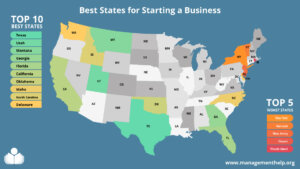Recruitment is always evolving. Companies that want to snag top-tier talent must stay up to date with the latest trends. One rising strategy shaking up the scene is reverse recruiting, which has gained some serious traction over the past few years.
In this guide, we’ll dive deep into reverse recruiting, what it is, why it’s valuable, how it operates, and how to measure its success. We’ll highlight a few standout reverse recruiting companies and explore other fresh options for those eager to experiment with something different. Ready to uncover everything about reverse recruiting? Let’s get into it!
>> Make Recruiters Come to You With Career Agents >>
The Best Reverse Recruiting Companies
Along with knowing the ideas and benefits of reverse recruiting, it’s critical to investigate some prominent reverse recruiting organizations and their services. Let’s look at two of them: Career Agents and Find My Profession.
Career Agents is a premier reverse recruiting firm that takes the stress out of job searching by managing the entire process on behalf of professionals. With over 20 years of industry expertise, their team of expert recruiters helps clients secure top roles faster and at higher compensation levels.
Their all-inclusive, done-for-you approach sets Career Agents apart: each client is assigned a dedicated Career Agent who handles everything, from resume and LinkedIn optimization to job application management, personalized outreach, interview coaching, and post-offer support. With daily updates, weekly coaching, and a job offer guarantee (or a partial refund), Career Agents delivers results with strategy, discretion, and efficiency.
>> Elevate Your Job Search With Career Agents >>
Find My Profession is a prominent player in reverse recruitment, offering a comprehensive suite of services tailored to empower candidates in shaping their career journey and forging connections with organizations that resonate with their aspirations.
Since 2015, Find My Profession has been providing reverse recruiting services to job seekers. Today, three package options are offered and the services includes resume, cover letter, and LinkedIn profile updates to ensure your marketing materials are optimized for your job search. Some packages include career coaching services for interview prep and salary negotiation, and a job offer guarantee.
>> Land Your Dream Job With Find My Profession >>
My Personal Recruiter offers a personalized reverse recruiting experience designed to streamline the job search process for professionals across various industries. The firm’s expert recruiters act as dedicated career partners, helping clients uncover job opportunities, craft compelling applications, and connect with employers that align with their career goals.
With a focus on tailored service and hands-on support, My Personal Recruiter simplifies every step of the journey—from resume optimization to interview prep—ensuring candidates stand out in a competitive job market.
>> Find Jobs With My Personal Recruiter >>
Honorable Mentions
Besides Find My Profession, several other noteworthy reverse recruitment firms, including Reverse Recruiter, Career Catalyst, and Job Search Genuis, have carved out distinctive niches. Each offers unique services tailored to the needs of candidates and organizations. These firms bring their unique approach and expertise, providing various options for individuals venturing into reverse recruitment.
Reverse Recruiting Defined
What Is Reverse Recruiting?
Reverse recruiting, also known as reverse job hunting, is an approach where the roles of job seekers and employers are flipped. Instead of candidates applying for positions, employers or recruiters actively seek out potential candidates.
Instead of the traditional recruitment approach where companies actively pursue and engage prospective employees, reverse recruiting encourages job seekers or passive candidates to initiate contact and interact with the organizations they want to work for.
This paradigm shift in power dynamics lets applicants control their career trajectory and swiftly showcase their skills and enthusiasm to potential employers.
>> Land Top Roles With Career Agents >>
What Does Career Agents Reverse Recruiting Solution Include?
The Reverse Recruiter program at Career Agents offers personalized job search assistance, including resume optimization and proactive job applications. Its unique focus is on catering to the specific needs of executives through tailored strategies and networking efforts.
- Initial Consultation: Understanding the client’s needs through a video conference call.
- Resume Writing Services: Optimizing the client’s resume, LinkedIn profile, and cover letter, with the flexibility to make unlimited edits.
- Job Applications and Networking: Actively contact organizations and apply for jobs on behalf of the client.
- Dashboard Utilization: Providing a digital dashboard for clients to track applications, interviews, and job offers and to communicate with their reverse recruiter.
Key Ideas Behind Reverse Recruiting
Reverse recruiting stands on a distinct set of principles that differentiate it from traditional recruitment methods:
- Candidate-Centric Philosophy: At its core, reverse recruiting prioritizes candidates’ needs and aspirations. This approach empowers candidates to seize control of their career paths and makes their goals a top priority.
- Active Candidate Engagement: Unlike conventional recruitment, where organizations drive the selection process, reverse recruiting prompts candidates to take the initiative and start contact with potential employers. This proactive engagement allows candidates to show their skills, expertise, and enthusiasm to organizations.
- Emphasis on Transparency and Authenticity: Reverse recruiting emphasizes transparency and authenticity throughout recruitment. Candidates are encouraged to openly share their genuine interests, motivations, and career aspirations, fostering more meaningful and mutually beneficial connections between job seekers and organizations.
>> Land Your Dream Job With Career Agents >>
Job Search Value Calculator (DIY vs Reverse Recruiting)
Management.org Job Search Calculator – estimate the financial impact of getting hired faster with professional help. Annual target salary (USD) Months to land a job on your own (DIY) Months to land a job with reverse recruiting help Cost of reverse recruiting service (USD) Calculate Value
Results
Time saved: months
Extra income from getting hired faster: $
Service cost: $
Estimated net value of reverse recruiting: $
Estimated ROI: %
Job Search Value Calculator (DIY vs Reverse Recruiting)
Management.org Job Search Calculator: estimate the financial impact of getting hired faster with professional help.
The Pluses of Reverse Recruiting
Reverse recruiting offers numerous benefits for organizations and candidates. Let’s explore some of the key advantages this approach offers.
1. Makes Passive Talent More Accessible
Reverse recruiting offers a significant advantage by unlocking the vast potential of passive talent. Passive candidates are individuals not actively hunting for new job prospects but might consider new opportunities if the perfect one comes along. Conventional recruitment approaches often find it challenging to reach these candidates, as they aren’t actively scouring job boards or submitting applications.
Yet, reverse recruiting empowers candidates to proactively reach out to companies that genuinely pique their interest, creating an opportunity to tap into a pool of highly skilled and experienced professionals who may have remained inaccessible through traditional methods.
2. Better Qualified Candidates
For numerous reasons, reverse recruiting often results in higher-quality applicants. When candidates approach an organization, they show genuine interest and excitement for the firm and its mission.
This self-selection procedure eliminates individuals who don’t match the organization’s values or goals. Reverse recruiting allows candidates to show their abilities, knowledge, and passion directly to the hiring team, allowing them to stand out.
As a result, companies are more likely to draw interest from driven, proactive, and engaged employees who are a good fit for the role and the business culture.
3. Enhances Your Company Reputation
In the age of employer branding, reverse recruiting may significantly enhance a company’s reputation as an employer of choice. Companies that aggressively invite prospects to converse with them show their open-mindedness, approachability, and commitment to building significant relationships.
This proactive method communicates an attractive message to potential candidates, promoting the organization as modern and farsighted. Positive corporate identity enhances overall brand credibility among clients and business associates.
4. Ensures a Better Cultural Fit
Selecting individuals who share the firm’s culture and values is critical for its continued success. Reverse recruiting provides a distinct advantage. When applicants contact a business on their initiative, they frequently undergo a thorough evaluation to verify their compatibility with the company’s culture, vision, and values. This congruence results in improved employee happiness and retention levels.
Reverse recruiting creates an environment where candidates feel comfortable sharing their interests and motivations, allowing firms to uncover employees genuinely passionate about their jobs and vision.
5. Cut Costs and Time Spent
Reverse recruiting can also save companies time and money throughout the employment process. Traditional recruitment approaches can take extensive time and effort to filter through many applications, do preliminary screenings, and coordinate interview logistics.
In reverse recruiting, the initial screening procedure is partially avoided because candidates have previously shown interest and motivation. This straightforward strategy enables companies to focus on evaluating the best prospects, accelerating the hiring process, and minimizing the time to hire.
>> Stand Out to Recruiters With Career Agents >>
The Mechanics of Reverse Recruiting
While reverse recruiting has significant benefits, businesses should implement it carefully and strategically. Look at the critical steps to making reverse recruiting work for your company.
1. Pinpoints More Ideal Candidates
The first step in reverse recruiting is intentionally discovering and targeting the ideal prospects. Organizations actively seek and engage with applicants who correspond with their needs and corporate culture rather than waiting for individuals to apply for job openings. Reverse recruiters use various channels, such as online professional networks, social media platforms, and industry-specific forums, to identify candidates.
Organizations must identify their desired candidate profiles to target the right people. They must determine the needed skills, experience, qualifications, and cultural fit. By explicitly outlining these criteria, organizations can focus on connecting with individuals who possess the required attributes and are likely to contribute to the company’s success.
2. Build an Authentic Employer Brand
Branding is critical in reverse recruitment because it assists firms in establishing a favorable and authentic image that attracts candidates. An employer brand is a company’s reputation, values, culture, work environment, and employee experiences. Organizations can use reverse recruitment to show their employer brand and differentiate themselves.
Organizations must establish and articulate distinctive values to build a genuine employer brand. What distinguishes them as an employer? What is the company culture like there? What prospects for advancement do they provide?
Answering these questions contributes to developing an exciting employer brand narrative that attracts candidates. Organizations can strengthen their employer brand by utilizing digital platforms such as the corporate website, social media, and employee testimonials.
>> Land Top Roles With Career Agents >>
How to Create a Thorough Reverse Recruitment Strategy
Reverse recruitment requires a well-thought-out plan to be successful. Organizations must address several critical factors:
1. Active Participation
Organizations should be proactive on critical platforms and channels where potential candidates engage. Companies need an up-to-date company website, active social media accounts, and industry event and forum attendance. Offering informative and insightful content establishes credibility and attracts potential applicants’ attention.
2. Recruiting Talent
In reverse recruiting, potential candidates who exhibit interest in the organization are actively engaged. Responding quickly to inquiries, engaging in meaningful conversations, and providing relevant information about the firm and its potential is critical. As a result, candidates feel valued, strengthening employer-candidate relationships.
3. Proactive Online Presence
Establishing a bold online presence is crucial for organizations in reverse recruitment. It involves maintaining an up-to-date company website, active engagement on social media, and participation in industry events and forums. By sharing valuable content, thought leadership, and industry insights, organizations can build credibility and attract the attention of potential candidates.
4. Active Candidate Engagement
In reverse recruitment, continuous engagement with potential candidates is critical. Proactive engagement entails swift responses to candidate inquiries, engaging in meaningful dialogues, and providing relevant information about the company and its opportunities. This communicative approach helps candidates feel valued and appreciated, strengthening the employer-candidate relationship.
5. Optimizing the Candidate Experience
Like creating a positive customer experience, optimizing the candidate experience is vital in reverse recruitment, including streamlining the application process, providing timely feedback, and maintaining fluid communication. These efforts help form a favorable candidate experience, even if a candidate isn’t ultimately hired, potentially leading to future referrals or interest in other roles within the organization.
6. Continuous Assessment and Enhancement
Reverse recruitment is an ongoing, iterative process. To excel in this approach, organizations should regularly assess the effectiveness of their targeting, branding, and overall strategy. Analyzing metrics such as candidate engagement, conversion rates, and the quality of hires helps identify areas for improvement and refinement in the reverse recruitment strategy.
>> Stand Out to Recruiters With Career Agents >>
Metrics to Measure Reverse Recruiting Success
Measuring reverse recruiting performance is critical for assessing its effectiveness and making data-driven decisions to improve the process. Let’s look at some fundamental criteria that businesses can use to determine the performance of their reverse recruiting initiatives.
Time-to-Fill
Time-to-fill is an important metric that tracks the time it takes from the start of the reverse recruitment process to the final selection and onboarding of a candidate. A quicker time-to-fill shows that the reverse recruiting strategy effectively attracts and engages qualified prospects.
It reflects the efficiency of the organization’s targeting, engagement, and selection procedures. When comparing the time-to-fill for reverse recruitment to traditional recruitment approaches, the relative speed and efficiency of the methodology are precise.
Cost Per Hire
Cost per hire is a metric that evaluates the financial investment needed to bring a candidate into an organization. It encompasses a range of expenses, such as advertising costs, recruitment agency fees, background checks, and onboarding expenditures.
When calculating the cost per hire for reverse recruitment, organizations can gauge the cost-effectiveness of this approach compared to traditional recruitment methods. If the cost per hire is either lower or on par while maintaining the quality of the candidate, it signifies the success of reverse recruitment in delivering efficient results.
Candidate Volume and Conversion Rates
The volume of candidates engaged through reverse recruitment is a vital assessment metric. It reflects the effectiveness of the organization’s targeting and branding endeavors in attracting potential candidates. A higher volume of candidates indicates a broader reach and heightened interest in the organization.
However, it’s equally essential to evaluate conversion rates, which measure the percentage of engaged candidates who progress through the recruitment stages and eventually become part of the organization. Elevated conversion rates suggest that the reverse recruitment process effectively identifies and engages candidates who align with the organization’s requirements and culture.
>> Land Top Roles With Career Agents >>
What Will Reverse Recruiting Cost?
While reverse recruiting offers numerous benefits, it’s essential to consider the associated costs, which can vary significantly among reverse recruiting firms. Firms can charge between $2499 and $4999 depending on the package.
The pricing structure may depend on the range of services provided and the level of support required. Several factors can influence these costs, including the complexity of job requirements, the degree of customization needed, and the extent of ongoing support throughout the recruitment process.
Reverse recruiting firms may have different pricing models. Their fees can range from flat rates to percentage-based costs tied to the candidate’s salary or a combination of these approaches. Some firms may offer tiered pricing based on the level of service and customization.
Reverse Recruiting Companies Pricing Comparison
| Company | Pricing & Model | Guarantee / Refund Policy |
|---|---|---|
| Career Agents | Tiered flat-fee packages — Starter: $1,499, Pro: $4,999, Executive: $9,999. Also available as monthly plans (about $833–$1,666 per month depending on package). | Only company offering a refund: 50% money-back guarantee if no job offer is secured within six months (for higher-tier clients). |
| Find My Profession | Monthly reverse recruiting service ranging from $1,499 to $4,500 per 30-day period. Resume, cover letter, and LinkedIn optimization are included. | 6-Month Job Offer Guarantee. If a job offer, or 5 interviews, is not secured in 6 months, services continue at no additional cost. |
| My Personal Recruiter | Subscription model with three tiers, typically between $799 and $1,999 per month depending on service level. Designed for executives and includes personalized outreach and ongoing updates. | No monetary refund, but if no job offer is received within six months, the company continues service at no extra cost until placement. |
Pricing Models Explained
Reverse recruiting companies generally use one of three pricing structures:
- Flat Fee: A one-time payment that covers the entire job search management process (used by Career Agents).
- Monthly Retainer: Pay per month or per 4-week period, offering flexibility and short-term commitment (used by Find My Profession and My Personal Recruiter).
- Performance Extensions: Some firms extend services without additional cost if placement takes longer than expected, though most do not offer cash refunds.
Among all providers, only Career Agents includes a partial 50% refund guarantee, which makes it the most risk-free option for clients seeking measurable results.
How Reverse Recruiting Pricing Works
The cost of reverse recruiting services can vary widely depending on several factors, including the firm you choose, the level of service and customization required, and the complexity of the job requirements. Pricing models may differ among companies, making it challenging to provide specific figures.
To give you a rough idea, here’s a general overview of potential pricing structures for reverse recruiting services:
- Flat Fee: Some reverse recruiting firms charge a fixed, upfront fee for their services. This fee can range from a few thousand dollars to tens of thousands, depending on the firm and the level of service.
- Percentage of Candidate’s Salary: Another standard pricing model involves charging a portion of the candidate’s first-year salary. This percentage typically falls within 15% to 30% but can vary.
- Tiered Pricing: Some firms offer tiered pricing based on the level of service and customization required. Higher tiers with more comprehensive services may be more expensive.
- Custom Quotes: Many reverse recruiting firms provide custom quotes based on your specific needs and the complexity of the recruitment process. These quotes can vary significantly.
- Additional Fees: Be aware that there may be additional fees for extra services, such as background checks, candidate assessments, or ongoing support.
Given this pricing diversity, contact reverse recruiting companies directly to inquire about their pricing structures and obtain personalized quotes. This will allow you to understand the costs associated with your particular recruitment needs and make an informed decision based on your budget and objectives.
>> Get Matched With Top Companies Using Career Agents >>
Alternatives to Reverse Recruiting
While reverse recruiting presents a practical approach, it’s imperative to recognize that it’s not the sole option available. Both organizations and candidates can explore various alternative recruitment methods to discover the ideal match. Here are some alternatives worth exploring:
- Traditional Recruitment: The conventional method entails organizations actively pursuing and engaging candidates through job postings, recruitment agencies, and networking. This approach affords organizations greater control over the candidate selection process.
- Employee Referrals: Employee referrals can be a valuable source of high-quality candidates. Organizations encourage their current employees to recommend potential candidates who might be an excellent fit for open positions.
- Job Fairs and Networking Events: Participation in job fairs and networking events offers organizations a chance to connect with potential candidates face-to-face. These events enable direct interactions and provide an opportunity to showcase the company culture and available options.
- Online Job Boards: Platforms like LinkedIn, Indeed, and Glassdoor are popular online job boards that facilitate connections between organizations and candidates. Organizations can post job openings, while candidates can search and apply for relevant positions.
The selection of the most suitable recruitment method hinges on various factors, including the specific role’s requirements, the target candidate pool, and the organization’s overall recruitment strategy. It’s prudent to consider a combination of recruitment methods to maximize the likelihood of finding the most qualified candidates.
>> Stand Out to Recruiters With Career Agents >>
Frequently Asked Questions
Reverse recruiting is a proactive approach to job searching that empowers candidates to take charge of their career opportunities. Below are answers to common questions about how it works and its benefits:
>> Make Recruiters Come to You With Career Agents >>
Conclusion
Reverse recruiting is a novel and effective technique for talent acquisition that empowers candidates to direct their careers and actively engage with enterprises. Organizations may attract high-quality candidates by targeting the right people, constructing an authentic employer brand, and implementing a strategic reverse recruitment plan.
Organizations can use Time-to-fill, cost-per-hire, and candidate engagement metrics to assess the performance of reverse recruitment initiatives. Investigating other recruitment strategies and considering costs can give businesses and candidates a comprehensive perspective. With the correct approach and mindset, reverse recruiting can transform the hiring process and lead to the identification of great talent.
 Sections of this topic
Sections of this topic



















